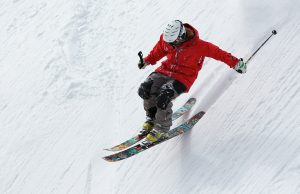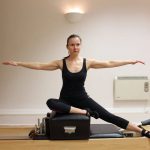
Each year as the snow begins to fall, ski enthusiasts hit the workouts in preparation for the upcoming season. Lot of people are performing typical plyometric and power lifting exercises in the leisure clubs. These exercises can increase speed on the slopes, but usually the form is faulted and injuries and compensations are observed.
Skilates is a ski conditioning and injury prevention exercise programme using Pilates-based ski/snowboard specific exercises and apparatus. Both the exercises and instruction within the lesson focus on principles of ski and snowboarding form, technique, and demands, as well as providing important muscle coordination and strengthening to prevent compensations and injuries. We educate and instruct the skier on proper core stabilisation, the importance of stability of pelvis/neutral spine with dynamic activities, and on key muscles in skiers that tend to get tight, or be improperly used, or overused due to other muscle imbalances.
Skiers and knee injuries
Skiers run the risk of many different injuries, but particularly issues with the knees. We see a lot of tears of the anterior cruciate ligament (ACL), medial collateral ligament (MCL), and the meniscus.
Equipment Pilates helps skiers to focus on a dynamic and full range of motion, as well as the strength of the hamstring muscles (back of the thigh), which helps to balance overused quadriceps (the front of the thigh), and serve as back up support for the ACL. Exercises that emphasize the adductors can help a skier’s recovery from catching an edge or keeping the skis under the center of the body, thus reducing the stress on other structures such as the MCL. In addition, closed chain exercises (where the foot is in contact with bar/strap/board/floor) help simulate proper muscle recruitment and timing, as well as provide functional applicable movements for skiing.
Using specific exercises to focus on the vastus medialis oblique (part of the quadriceps) and gluteus medius (on the side of the buttock) are important for proper patella (knee cap) tracking and stability of the knee and hip joints.
Skiers and lower back injuries
Another area we see injured or overused a lot in skiing is the lower back. Injuries here often occur from form fatigue and poor core stabilization. Often the hip or lower extremity moves and then the pelvis and lumbar spine follow, increasing the stress on the spine as well as causing unnecessary muscle imbalances, compensations, and ultimately injuries. In the Skilates lesson we teach individuals to gain control of trunk stability to maximize extremity mobility and efficiency, which is taught by proper abdominal recruitment.
Physio4Life has a great team of health and fitness professionals which will assist you with your skiing preparation. Telephone: 020 8704 5998, or message the team here.
By Bonnie Ryckova
Personal Trainer and Rehabilitation Pilates teacher




